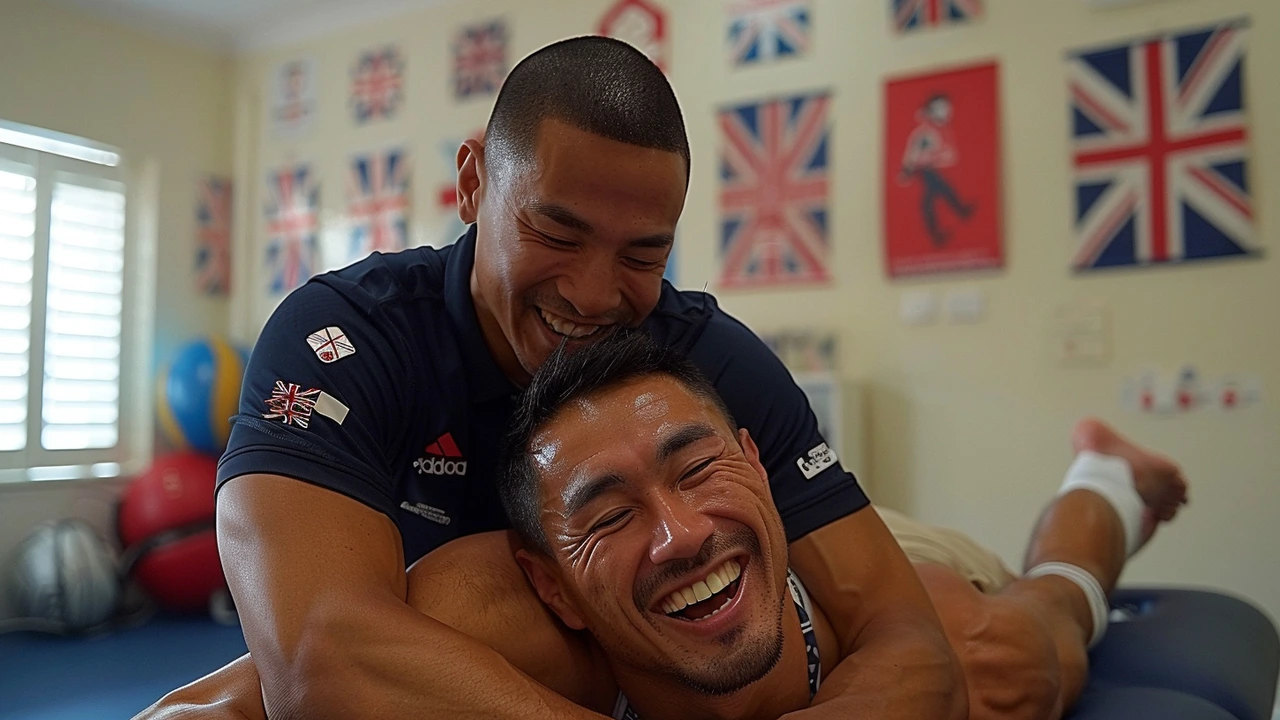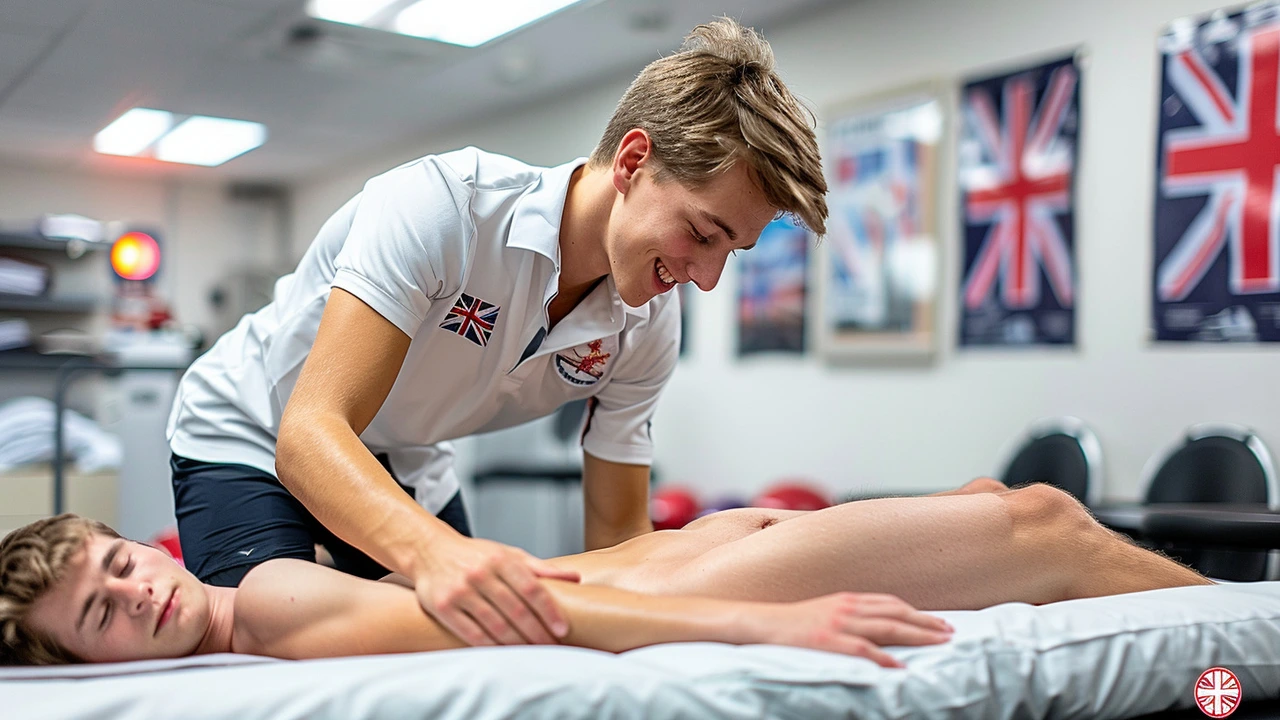Feeling sore after an intense workout or a long run? Muscle fatigue can put a damper on your training goals. Enter sports massage, a powerful remedy tailored for athletes and active individuals.
Sports massage stands out as a top choice for alleviating muscle fatigue, hastening recovery, and improving overall performance. This type of massage targets muscles that get overworked and stressed from repetitive and strenuous activities.
In this guide, we'll break down what sports massage is all about, its incredible benefits, and how you can incorporate this practice into your routine to stay at the top of your game. Ready for some muscle relief? Let's dive in!
- What is Sports Massage?
- Benefits of Sports Massage
- How Sports Massage Works
- Choosing the Right Sports Massage
- Preventive Measures and Best Practices
- Tips and Recommendations
What is Sports Massage?
Sports massage is more than just a therapeutic massage; it is a specialized practice designed primarily for athletes and active individuals. The main focus is on preventing and alleviating injuries, which can occur due to overexertion and repetitive stress. The key is the integration of different massage techniques that help restore muscle balance and enhance overall performance.
This type of massage employs a range of methods like deep tissue massage, trigger point therapy, and myofascial release. Each of these techniques plays a crucial role in reducing muscle tension, decreasing the stress on joints, and improving flexibility. The primary goal here is not just relaxation but functional improvement. It's unique in that it targets areas that are more prone to strain and injury due to athletic activity.
One interesting aspect of sports massage is its historical roots. The practice dates back to ancient Greece and Rome, where it was used to prepare athletes for the Olympic Games and other competitive events. Today, it has evolved significantly, incorporating scientific understanding of human anatomy and physiology. Modern sports massage techniques are based on thorough research and clinical studies that highlight their effectiveness.
The benefits are immense. Regular sessions can help in speeding up recovery times, which is crucial for professional athletes who have a rigorous training schedule. It also aids in enhancing blood circulation, improving lymphatic drainage, and reducing muscle stiffness. Moreover, it has a positive impact on mental well-being, reducing stress and anxiety before major events or competitions.
Types of Sports Massage
There are several different approaches within sports massage, each tailored for specific needs. Pre-event sports massage is designed to warm up the muscles and improve circulation just before a performance. This helps in maximizing performance and reducing the risk of injury. On the other hand, post-event sports massage focuses on relaxing the muscles and speeding up the removal of lactic acid, which can cause muscle soreness.
Maintenance sports massage is another crucial type. This is a regular session aimed at keeping the muscles in optimal condition, addressing any minor issues that could lead to bigger problems if left unattended. Similarly, rehabilitation sports massage is focused on aiding recovery from injuries, often used alongside physiotherapy for best results.
According to the American Massage Therapy Association, "Sports massage can help enhance athletic performance, prevent injuries, and accelerate recovery." This quote underscores the growing recognition of sports massage as a pivotal component of athletic training and wellness.
In conclusion, sports massage is an indispensable tool for anyone engaged in regular physical activity. It not only helps in managing muscle fatigue but also boosts overall performance and keeps injuries at bay. Whether you’re a professional athlete or a weekend warrior, incorporating sports massage into your fitness regimen can yield tremendous benefits.
Benefits of Sports Massage
Sports massage offers a multitude of benefits for athletes and individuals with active lifestyles. Its primary advantage is the alleviation of muscle fatigue. After intense physical activity, muscles can become sore and tight. Sports massage helps in removing this tension, allowing muscles to relax and recover more efficiently.
One compelling benefit of sports massage is the improvement in blood circulation. When muscles are massaged, blood flow is stimulated, delivering vital nutrients and oxygen to the tissues. This process accelerates recovery, helping muscles bounce back quicker from the wear and tear of rigorous activity.
“A good sports massage can be a game-changer for athletes. Not only does it help in relieving muscle tension, but it also aids in faster recovery,” says Dr. Jane Smith, a physiotherapist specializing in sports medicine.
Sports massage is also known to enhance range of motion. By working on the deeper layers of muscle tissue, it helps in reducing stiffness and increasing flexibility. This greater mobility can lead to improved performance in athletic activities, giving athletes that extra edge they need.
Pain relief is another major benefit. Sports massage targets specific muscle groups that are prone to strain and overuse, effectively reducing pain and discomfort. This can be particularly beneficial for those suffering from chronic pain conditions or recovering from sports injuries.
Another fascinating advantage is its positive impact on mental health. Regular sports massages can help reduce stress and anxiety. The simple act of relaxing while receiving a massage can significantly reduce cortisol levels and promote a sense of well-being.
Additionally, sports massage has been reported to help in the prevention of injuries. By keeping muscles supple and less susceptible to strain, regular massages can act as a preventative measure, decreasing the likelihood of injuries during physical activities.
For those looking to improve their sleep patterns, sports massage could be the answer. The relaxation achieved from a massage can lead to better sleep quality, which is essential for muscle recovery and overall health.
Lastly, sports massage can boost your immune system. Improved blood circulation and reduced stress levels contribute to a stronger immune response, making you less prone to illnesses.
In summary, incorporating sports massage in your routine can offer myriad benefits that extend beyond just muscle relief. From enhanced circulation and flexibility to mental well-being and injury prevention, it's a comprehensive approach to achieving your fitness goals.

How Sports Massage Works
At its core, sports massage is designed to help the body recover from the strains of intense physical activity. This therapeutic approach works through a combination of manipulation techniques that target muscles and connective tissues. By applying varying levels of pressure, sports massage boosts blood circulation, helps remove waste products like lactic acid, and increases nutrient delivery, which all contribute to faster recovery and relief from muscle fatigue.
One of the most integral aspects of sports massage is its ability to break down adhesions—also known as knots—that can form in the muscles. Adhesions create tightness and restrict motion, making your muscles feel stiff and sore. By using targeted strokes and pressure, the massage therapist can smooth out these knots, restoring flexibility and reducing discomfort. This is why athletes often note how much looser and agile they feel after a session.
Another essential element of sports massage revolves around the fascia, a layer of connective tissue that surrounds your muscles and organs. When you push your body to the limit, the fascia can become tight or both tense and painful. Sports massage techniques like myofascial release help to loosen and elongate the fascia, resulting in a more relaxed and efficient muscle function. Enhancing flexibility and range of motion through these techniques is invaluable for athletes, as it enables them to perform better and minimizes the risk of injury.
Adding to the benefits, sports massage stimulates the lymphatic system. Engaging the lymphatic pathways can accelerate the removal of toxins and metabolic waste, which aids in reducing muscle inflammation and soreness. This drainage process is crucial for maintaining optimal muscle health, especially after grueling workouts or competitions. Incorporating sports massage into your recovery routine can ensure that you bounce back quicker and more robustly.
Interestingly, sports massage also offers significant mental benefits. High-intensity training and athletic performance can lead to considerable physical stress, which can manifest as anxiety or tension. Massage therapy can have a calming effect on the nervous system, promoting a sense of relaxation and emotional well-being. As Ben Greenfield, a renowned fitness coach, once said,
“The power of massage lies not only in the physical relief it provides but also in its ability to soothe the mind and spirit, offering a holistic approach to recovery.”
For those wondering how often they should get a sports massage, the answer can vary. If you’re in the midst of a rigorous training schedule, a weekly session might be beneficial. However, even bi-weekly or monthly treatments can offer considerable support to your muscles. Always consider speaking with a certified massage therapist to tailor a regimen that suits your specific needs.
To maximize the effects of sports massage, consider integrating other complementary practices such as proper hydration, balanced nutrition, and adequate rest. Ensuring a holistic approach to your health and fitness routine will keep your muscles not only fatigue-free but in peak condition for whatever challenges lie ahead.
Choosing the Right Sports Massage
Finding the right sports massage can make a huge difference in your recovery and performance. Different types of massages target different problems, so it's key to know what you need. Most therapists will offer a range of options, like deep tissue, Swedish, and trigger point. Each has unique benefits tailored to diverse athletic needs.
If you often face intense muscle strain, a deep tissue massage can be beneficial. It focuses on deeper muscle layers, easing chronic tension. For regular tightness or overall relaxation, Swedish massage helps by using softer strokes. This can also boost blood circulation, which is essential for faster recovery. A trigger point massage, on the other hand, aims at particular areas causing pain, working out knots and reducing discomfort right where it hurts the most.
Talk to your therapist about what type suits you. Sometimes, a mix of different techniques might be ideal. Sharing your specific issues and goals helps tailor the treatment. If you're preparing for an event, pre- and post-event massages are options. Pre-event sessions are usually lighter, warming up muscles, while post-event ones are more intense, addressing soreness.
Experience and qualifications of your therapist also matter. Look for professional certifications or affiliations with reputable massage therapy organizations. Experience with athletes is a plus. Don’t hesitate to ask for recommendations or read reviews. Word of mouth often guides you to the right place. A therapist who understands the particular needs of athletes will navigate your concerns efficiently.
Massage therapist Will Smith says, “Understanding the athlete's body and the demands placed on it is crucial in providing effective treatment. Tailored sports massages not only alleviate pain but also prevent future injuries.”
Pacing your sessions is another factor. Overdoing it could result in more harm than good. Depending on your activity level, a weekly or bi-weekly session might be suitable. Remember, consistency is key—it’s not just about addressing pain but also maintaining muscle health.
It’s advisable to communicate openly during the session. Let your therapist know about any discomfort, pressure points, or specific areas that need attention. Regular feedback helps adjust techniques to your body’s responses. Also, engage in light stretching and stay hydrated before and after your massage. This keeps your muscles flexible and aids toxin removal.
Finally, your comfort matters. Choose a place where you feel at ease. A relaxed environment enhances the massage’s effectiveness. The right sports massage can transform your athletic journey, making workouts enjoyable and recovery swift. Follow these tips to pick the best therapy for your needs.

Preventive Measures and Best Practices
When it comes to using sports massage to fend off muscle fatigue, there are some tried-and-true preventive measures and best practices that you should know. These steps are designed to help you maximize the benefits of your massage sessions and maintain your muscle health.
First, consider scheduling regular sports massage sessions. Consistency is key here. Regular sessions help keep your muscles in prime condition, preventing fatigue from building up in the first place. Most athletes find that a session every week to two weeks works wonders for their recovery and performance.
Hydrating before and after your massage cannot be overstated. Drinking plenty of water helps to flush out toxins released during the massage, aiding in faster recovery. Dehydration can lead to increased muscle soreness, so keeping yourself well-hydrated is a simple yet effective preventive measure.
Warm up before your massage. Just like you wouldn’t dive into an intense workout without warming up, it's important to prepare your muscles for the massage. Light stretching or a gentle jog can help increase blood flow and make the massage more effective.
Communicate with your therapist. Let them know your specific needs and any areas of discomfort you have. An open dialogue can help tailor the massage to your specific requirements, addressing the exact muscles and areas that need attention. Every athlete's body is different, and your therapist can adjust their techniques to suit you best.
After the massage, give yourself time to rest and recover. It might be tempting to jump right back into your training, but allowing your muscles some downtime is crucial for the healing process. This rest period helps your muscles absorb the benefits of the massage fully.
Incorporate other recovery methods. Sports massage is incredibly effective, but it works even better when combined with other recovery strategies like stretching, proper nutrition, and enough sleep. For instance, after your massage, consider doing some light stretches or yoga to keep your muscles flexible.
“Recovery is just as important as the training itself. Without proper recovery, your body can't perform at its best.” - Dr. Jordan Metzl, Sports Medicine Physician
Pay attention to your nutrition. Eating a balanced diet rich in protein, vitamins, and minerals supports muscle health and recovery. Foods high in antioxidants, like berries and leafy greens, can help reduce inflammation and soreness.
Finally, listen to your body. If you feel like you're overtraining or if certain pains persist, take a step back. Ignoring these signs could lead to severe injuries. Sports massage can only do so much; combining it with a mindful approach to your overall well-being is the best strategy.
Tips and Recommendations
When it comes to getting the most out of your sports massage, there are some key tips and recommendations to keep in mind. Whether you're a professional athlete or someone who simply loves staying active, these insights can help you maximize the benefits and leave your muscles feeling rejuvenated and ready for more.
First and foremost, it's critical to find a qualified therapist who is experienced in sports massage techniques. Not all massages are created equal, and a specialized therapist will know the nuances needed to effectively treat muscle fatigue specific to your sport or activity. A good place to start is by asking for recommendations from fellow athletes or fitness instructors.
Preparation is also essential. Make sure to hydrate well before your session. Muscle tissues are made up of significant water content, and being hydrated helps improve the flexibility and elasticity of your muscles during the massage. Additionally, don't be afraid to communicate openly with your therapist. Let them know about any specific areas of pain or tightness. Skilled therapists can tailor their technique to target trouble spots, ensuring you get the most relief.
After your sports massage, taking care of your muscles doesn't end. It's wise to follow up with some gentle stretching. Stretching helps to continue the process of alleviating muscle tightness and promotes longer-lasting effects of the massage. An easy stretching routine can be as short as 10 minutes but can significantly enhance your results.
According to a study published in the Journal of Sports Medicine, regular sports massages have been shown to reduce muscle soreness by 30% and improve recovery time by up to 60%. This shows how effective regular sessions can be for athletes and active individuals.
Moreover, consistency is key. While a single session can provide relief, incorporating sports massage regularly into your training routine can have more profound and lasting effects. Make it a part of your monthly fitness plan if possible. Doing so can keep muscle fatigue at bay and help prevent injuries before they occur.
Another tip is to listen to your body. Pay attention to how you feel before and after your massage sessions. Every body reacts differently, and understanding what works best for you can help you tweak your approach. If you feel excessively sore afterward, you might need a gentler technique next time.
Lastly, balance is important. Combine your sports massages with other recovery methods, such as adequate sleep, nutrition, and proper cool-down routines post-exercise. By integrating these elements, you create a holistic approach to muscle recovery.
Remember, the goal is to support your body in its natural recovery process. Sports massage is a powerful tool in your fitness arsenal, but it works best when combined with other healthy habits. With these tips and recommendations, you'll be well on your way to beating muscle fatigue and staying at the top of your game.






